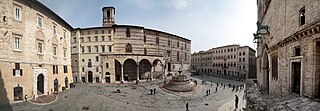
Perugia is the capital city of Umbria in central Italy, crossed by the River Tiber, and of the province of Perugia. The city is located about 164 km (102 mi) north of Rome and 148 km (92 mi) southeast of Florence. It covers a high hilltop and part of the valleys around the area. The region of Umbria is bordered by Tuscany, Lazio, and Marche.

Todi is a town and comune (municipality) of the province of Perugia in central Italy. It is perched on a tall two-crested hill overlooking the east bank of the river Tiber, commanding distant views in every direction. It was founded in antiquity by the Umbri, at the border with Etruria; the family of Roman Emperor Trajan came from Todi.
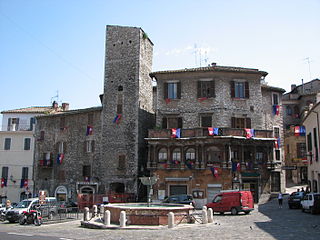
Narni is an ancient hilltown and comune of Umbria, in central Italy, with 19,252 inhabitants (2017). At an altitude of 240 m (787 ft), it overhangs a narrow gorge of the Nera River in the province of Terni. It is very close to the geographic center of Italy. There is a stone on the exact spot with a sign in multiple languages.

Volterra is a walled mountaintop town in the Tuscany region of Italy. Its history dates from before the 8th century BC and it has substantial structures from the Etruscan, Roman, and Medieval periods.

The Palazzo Vecchio is the town hall of Florence, Italy. It overlooks the Piazza della Signoria, which holds a copy of Michelangelo's David statue, and the gallery of statues in the adjacent Loggia dei Lanzi.

Monti is the 1st rione of Rome, identified by the initials R. I, located in Municipio I. The name literally means "mountains" in Italian and comes from the fact that the Esquiline, the Viminal Hills, and parts of the Quirinal and the Caelian Hills belonged to this rione: currently, however, the Esquiline Hill belongs to the rione Esquilino.

Parione is the 6th rione of Rome, identified by the initials R. VI, and belongs to the Municipio I. Its name comes from the fact that in the area there was a huge ancient wall, maybe belonging to the stadium of Domitianus; the nickname people gave to this wall was Parietone, from which the name "Parione".

Regola is the 7th rione of Rome, Italy, identified by the initials R. VII, and belongs to the Municipio I. The name comes from Arenula, which was the name of the soft sand that the river Tiber left after the floods, and that built strands on the left bank.

Borgo is the 14th rione of Rome, Italy. It is identified by the initials R. XIV and is included within Municipio I.

The Sanctuary of Macereto is a Renaissance-style chapel or Marian shrine in Visso, province of Macerata, Marche, Italy. Built between 1528 and 1538 around a rustic 14th-century chapel housing a venerated statue of the Madonna, it is located in the Parco Nazionale dei Monti Sibillini.
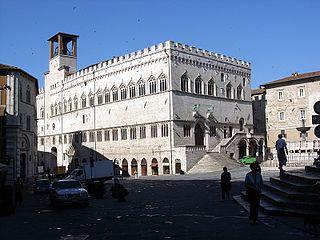
The Palazzo dei Priori or comunale is one of the best examples in Italy of a public palace from the communal era. It is located in the central Piazza IV Novembre in Perugia, Umbria. It extends along Corso Vannucci up to Via Boncambi. It still houses part of the municipality, and, on the third floor, the Galleria Nazionale dell'Umbria. It takes its name from the Priori, the highest political authority governing the city in the medieval era.

The Galleria Nazionale dell'Umbria the Italian national paintings collection of Umbria, housed in the Palazzo dei Priori, Perugia, in central Italy. Located on the upper floors of the Palazzo dei Priori, the exhibition spaces occupy two floors and the collection comprises the greatest representation of the Umbrian School of painting, ranging from the 13th to the 19th century, strongest in the fourteenth through sixteenth centuries. The collection is presented in 40 exhibition rooms in the Palazzo. On the second floor of the Gallery, there is an exhibition space for temporary collections, changed several times a year.

The Palazzo Brignole Sale or Palazzo Rosso is a house museum located in Via Garibaldi, in the historical center of Genoa, in Northwestern Italy. The palace is part of the UNESCO World Heritage Site Genoa: Le Strade Nuove and the system of the Palazzi dei Rolli. The rich art collection inside, along with the galleries of Palazzo Bianco and Palazzo Doria Tursi, is part of the Musei di Strada Nuova and consists of the works of artists of the caliber of Antoon van Dyck, Guido Reni, Paolo Veronese, Guercino, Gregorio De Ferrari, Albrecht Dürer, Bernardo Strozzi and Mattia Preti.
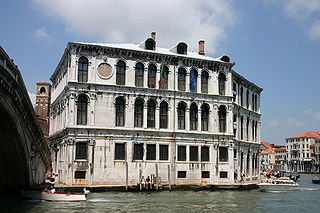
Palazzo dei Camerlenghi is a Renaissance palazzo in Venice, northern Italy, located in the sestiere (quarter) of San Polo. It faces the Canal Grande, adjacent to the Rialto Bridge.

Piazza del Popolo is a city square in Todi, Italy.

Palazzo del Popolo, also called Palazzo del Priori or Podesta, is a Gothic architecture civic palace in Todi, region of Umbria, Italy.

The Biblioteca Civica Romolo Spezioli or Biblioteca Civica di Fermo is a public library located on the Piazza del Popolo in the town center of Fermo, region of Marche, Italy.
San Giuseppe dei Falegnami is a small Baroque-style, Roman Catholic church or oratory located at the corner of Via San Giuseppe and Via di Mezzo Muro in the center of Todi, province of Perugia, region of Umbria, Italy. The church was commissioned by the guild of carpenters and furniture-makers, who often took St Joseph as their patron. While the guild was present in Todi by 1282, the church was not erected until 1612. The main altar depicting the Holy Family with Joseph the carpenter (1623) was painted by Andrea Polinori.
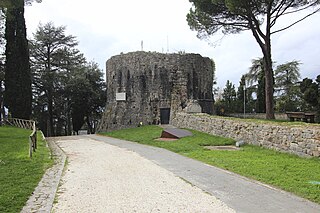
The Todi Columns are four Corten steel columns designed by the American artist Beverly Pepper, and now installed at the Beverly Pepper park located on Via Valle Inferiore #6 in Todi, region of Umbria, Italy. The site is part of the Parco della Rocca: a park built at the ruins of a 14th-century castle, of which a crumbling round former stone keep (donjon) rises a few yards from the columns. The park has a view south and east along a valley of the Tiber river.



















